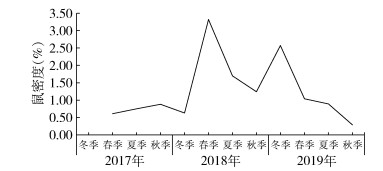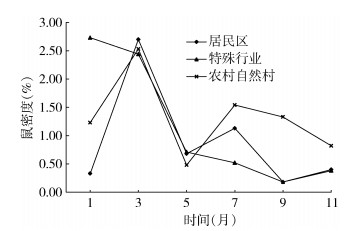引用本文 | 0 |
司晓艳, 白国辉, 宋利桃, 师婷, 南晓伟, 陈继来, 张忠兵, 高雨龙, 贺蕊霞, 郭惠敏. 内蒙古自治区人居环境2017-2019年鼠类监测数据分析[J]. 中国媒介生物学及控制杂志, 2021, 32(5): 586-589.

SI Xiao-yan, BAI Guo-hui, SONG Li-tao, SHI Ting, NAN Xiao-wei, CHEN Ji-lai, ZHANG Zhong-bing, GAO Yu-long, HE Rui-xia, GUO Hui-min. An analysis of rodent surveillance data in human settlements of Inner Mongolia, China, in 2017-2019[J]. Chin J Vector Biol & Control, 2021, 32(5): 586-589.

内蒙古自治区人居环境2017-2019年鼠类监测数据分析
司晓艳1

,
白国辉1
,
宋利桃1

,
师婷1

,
南晓伟1
,
陈继来1
,
张忠兵1
,
高雨龙1
,
贺蕊霞2


,
郭惠敏3


1 内蒙古自治区综合疾病预防控制中心病媒生物防制科/布病科, 内蒙古 呼和浩特 010031;
2 乌兰察布医学高等专科学校, 内蒙古 乌兰察布 012000;
3 复旦大学生命科学学院, 上海 200082
收稿日期: 2021-06-16
基金项目: 内蒙古自治区自然科学基金面上项目(2020MS08057);农业虫害鼠害综合治理研究国家重点实验室开放课题(IPM2006);中国科学院科技服务网络计划(STS计划)(KFJ-STS-ZDTP-2021-002-01-01)
作者简介:
司晓艳, 女, 主管技师, 主要从事鼠疫防控和病媒生物防制工作, E-mail: 372304169@qq.com;
宋利桃, 女, 副主任技师, 主要从事微生物检验工作, E-mail: songlitao789@126.com;
师婷, 女, 主管技师, 主要从事病媒生物防制工作, E-mail: 673266592@qq.com
司晓艳、师婷和宋利桃为共同第一作者
摘要: 目的 通过对内蒙古自治区(内蒙古)2017-2019年人居环境鼠类监测结果分析,了解和掌握该地区人居环境鼠的种类构成、分布、季节消长和在不同环境的鼠密度等规律,为制定该地区鼠类预防和控制方案提供参考依据。方法 采用夹夜法和路径法进行鼠密度监测,每2个月(单月监测)监测1次,每监测月中旬开展监测,2次监测时间间隔≥30 d,监测点包括城市居民区、特殊行业和农村自然村3种环境类型,单月监测时每个监测点布放有效夹>200夹。所得数据使用Excel 2013软件进行整理,用SPSS 25.0软件进行统计学分析,率的比较采用χ2检验。结果 2017-2019年内蒙古地区鼠平均密度为0.53%,小家鼠为该地区的优势鼠种,其次为褐家鼠,构成比分别为67.57%和25.94%,其他鼠种占6.49%;鼠密度出现了2个高峰,即2018年春季和2019年冬季,夏、秋季密度一般较低;不同环境类型的鼠密度以农村自然村最高,为1.10%,不同环境鼠密度差异有统计学意义(χ2=51.188,P<0.001)。结论 内蒙古地区不同年份、不同生境的鼠密度与季节消长变化趋势均有差异,故应有针对性地采取综合防治措施,有效降低该地区人居环境鼠密度,从根本上控制鼠传疾病的发生风险。
关键词:
鼠密度 种群构成 季节消长 监测
An analysis of rodent surveillance data in human settlements of Inner Mongolia, China, in 2017-2019
SI Xiao-yan1

,
BAI Guo-hui1
,
SONG Li-tao1

,
SHI Ting1

,
NAN Xiao-wei1
,
CHEN Ji-lai1
,
ZHANG Zhong-bing1
,
GAO Yu-long1
,
HE Rui-xia2


,
GUO Hui-min3


1 Department of Vector Control and Brucellosis Prevention and Control, Inner Mongolia Autonomous Region Comprehensive Center for Disease Control and Prevention, Hohhot, Inner Mongolia 010031, China;
2 Ulanqab Medical College, Ulanqab, Inner Mongolia 012000, China;
3 College of Life Sciences, Fudan University, Shanghai 200082, China
Supported by the Natural Science Foundation of Inner Mongolia Autonomous Region of China (No. 2020MS08057), Open Project of the State Key Laboratory of Integrated Management of Pest Insects and Rodents (No. IPM2006) and the Science and Technology Service Network Initiative of Chinese Academy of Science (No. KFJ-STS-ZDTP-2021-002-01-01)
Abstract: Objective To investigate the species composition, distribution, seasonal variation, and density of rodents in different environments by analyzing rodent surveillance data in human settlements of Inner Mongolia autonomous region (Inner Mongolia), China, in 2017-2019, and to provide a reference for rodent prevention and control in Inner Mongolia. Methods The trap-at-night method and the path method were used to monitor rodent density once every two months (in odd months), and monitoring was performed in the middle ten days of each odd month, with an interval of no less than 30 days. Surveillance sites were selected from three habitats of urban residential area, special industry, and rural villages, and more than 200 effective traps were placed at each surveillance site in each odd month. Excel 2013 software was used for data analysis, SPSS 25.0 software was used for statistical analysis, and the chi-square test was used for comparison of rates. Results The mean rodent density in Inner Mongolia was 0.53% in 2017-2019, and the dominant species was Mus musculus, followed by Rattus norvegicus, with a composition ratio of 67.57% and 25.94%, respectively, and the other rodent species accounted for 6.49%. There were two peaks in rodent density, namely spring of 2018 and winter of 2019, and the density was generally low in the summer and the autumn. Rural villages had the highest rodent density of 1.10%, and there was also a significant difference in rodent density between different habitats (χ2=51.188, P<0.001). Conclusion There are differences in rodent density and seasonal variation between different years and habitats. Therefore, comprehensive prevention and control measures should be taken to effectively reduce rodent density in human settlements and fundamentally control the risk of rodent-borne diseases.
Key words:
Rodent density Species composition Seasonal variation Surveillance
内蒙古自治区(内蒙古)地处华北地区,位于北纬37°24′~53°23′,东经97°12′~126°04′,为温带大陆性气候,夏季温暖多雨,秋季凉爽昼夜温差大,冬季干燥寒冷[1]。Gubler等[2]、Enscore等[3]和刘起勇[4]认为鼠传疾病的流行与气候因素有关,内蒙古地区的地势和气候适合大部分鼠类栖息。该地区鼠疫疫源地类型多、分布广、面积大,且城市环境中的居民区、农贸市场、餐饮店等又为鼠类的生长繁殖提供了自然的生存空间。鼠类可携带多种细菌、病毒、寄生虫,传播多种细菌性疾病、病毒性疾病以及寄生虫病[5],如肾综合征出血热(HFRS)、地方性斑疹伤寒、钩端螺旋体病(钩体病)、莱姆病等[6]。鼠传疾病的传播途径较易实现[7],一旦传播鼠类传染病,会对全民健康水平和社会经济发展造成严重影响。为此,我们于2017-2019年对内蒙古地区人居环境鼠的种类构成、分布、季节消长和不同环境的鼠密度进行了调查,为内蒙古地区制定鼠传疾病预防和控制方案提供参考依据。
1 材料与方法
1.1 数据来源 数据来自于2017-2019年内蒙古呼和浩特、巴彦淖尔、通辽和乌兰察布市4个国家级监测点的鼠类监测数据。
1.2 监测生境选择 按照《内蒙古自治区病媒生物监测实施方案》要求,按地理位置选择居民区、特殊行业(餐饮店、食品制售、建筑工地、屠宰场、酿造业等)、农村自然村3类生境各2处。
1.3 监测方法 按照《内蒙古自治区病媒生物监测实施方案》要求,采用分层随机抽样选取监测点,室内鼠类监测采用夹夜法,对每个监测点单月中旬监测1次。鼠夹统一选用中型钢板夹(12 ㎝×6.5 ㎝),以各地便于获得的材料为诱饵长期使用,晚放晨收。单月每个生境布放≥200个有效夹。
1.4 统计学分析 采用Excel 2013软件进行数据整理,用SPSS 25.0软件进行统计学分析,率的比较采用χ2检验,P < 0.05为差异有统计学意义。
2 结果
2.1 各监测点鼠密度及鼠种构成 2017-2019年共布放鼠夹34 831夹次,捕鼠185只,平均鼠密度为0.53%。除2018年鼠密度(1.37%) > 1.00%外,其他年份鼠密度均 < 1.00%(表 1)。各监测点鼠密度以呼和浩特市最低为0.31%,通辽市最高为2.89%,乌兰察布与巴彦淖尔市鼠密度相同,均为0.58%。从鼠种构成来看,小家鼠(Mus musculus)为优势种,占捕获总数的67.57%,其次为褐家鼠(Rattus norvegicus),占25.94%,其他鼠种占6.49%(表 1)。经χ2检验,各年间鼠种构成差异有统计学意义(χ2=26.176,P < 0.05)。
表 1 2017-2019年内蒙古自治区人居环境鼠密度及构成
Table 1 Rodent density and species composition in human settlements of Inner Mongolia, 2017-2019
2.2 鼠密度季节消长 从季节分布来看,内蒙古地区2017年春季至2019年冬季,鼠密度出现了2个高峰,即2018年的春季和2019年的冬季(图 1),夏、秋季密度一般较低。
2.3 不同生境鼠密度 不同生境中鼠密度最高的为农村自然村,平均为1.10%,特殊行业(餐饮店、食品制售、建筑工地、屠宰场、酿造业等)和居民区分别为0.40%和0.39%(表 2),不同生境的鼠密度差异有统计学意义(χ2=51.188,P < 0.001)。不同生境中,居民区的优势鼠种依次为小家鼠、其他鼠种和褐家鼠,分别占捕获总数的81.10%、13.77%和5.13%;特殊行业的优势鼠种依次为小家鼠、褐家鼠和其他鼠种,分别占76.24%、22.91%和0.85%;农村自然村优势鼠种依次为小家鼠、褐家鼠和其他鼠种,分别占68.35%、29.35%和2.30%。见表 2。
表 2 2017-219年内蒙古自治区人居环境不同生境鼠密度(%)
Table 2 Rodent density in different habitats in human settlements of Inner Mongolia, 2017-2019
2.4 不同生境鼠密度季节消长 2017-2019年不同生境鼠类活动呈双峰曲线,3月与7月各有一密度高峰。见图 2。
3 讨论 小家鼠是与人类伴生的家野两栖小型鼠类,褐家鼠以家栖为主。在北方地区,小家鼠与褐家鼠均常年生活在人类建筑物中,包括农村自然村与居民区。小家鼠与褐家鼠的危害是多方面的:(1)小家鼠与褐家鼠盗取粮食,危害农作物,是重要的农田害鼠,对人类危害十分严重[7]。(2)小家鼠与褐家鼠可传播多种鼠传疾病,例如小家鼠与褐家鼠均可传播HFRS、钩体病等,小家鼠还可传播地方性斑疹伤寒,褐家鼠还可传播布鲁氏菌病[8]。小家鼠与褐家鼠的食物来源主要来自农作物,农村防鼠防病意识、环境设施及其管理较为薄弱,这可能是农村自然村鼠密度大于其他生境的原因。监测结果显示,内蒙古地区人居环境鼠密度冬、春季节较高,夏、秋季节较低,一方面小家鼠与褐家鼠有明显的季节性迁徙,大部分会于冬季进入房屋中越冬,这与《宁夏啮齿动物与防制》[9]和《内蒙古啮齿动物》[10]中的结果相一致;另一方面,内蒙古地区历年会在鼠类活动高峰季节(例如夏季和秋季)重点开展灭鼠活动,在冬季时灭鼠活动会减少,鼠密度增高。鼠密度一般呈周期性变化[11-16],2017-2019年内蒙古地区不同生境鼠密度季节消长呈双峰分布,且2019年冬季鼠密度有明显增高现象。鼠密度一般受温度、湿度等气候因素影响较大,内蒙古地区的气候为鼠类生存与繁殖提供了条件,2019年多雨,水草丰茂,给鼠类提供了丰沛的食物资源和充分的栖息活动场所[12],故推测这是2019年冬季出现鼠密度高峰的原因。
利益冲突 无
参考文献
| [1] |
郝静云, 朱明达, 于占海. 内蒙古边境地区鼠疫自然疫源地景观特征的研究[J]. 口岸卫生控制, 2010, 15(6): 49-50. Hao JY, Zhu MD, Yu ZH. Research on landscape features of plague natural foci at Inner Mongolia border area[J]. Port Health Controrl, 2010, 15(6): 49-50. DOI:10.3969/j.issn.1008-5777.2010.06.015 |
|
| [2] |
Gubler DJ, Reiter P, Ebi KL, et al. Climate variability and change in the United States: potential impacts on vector- and rodent-borne diseases[J]. Environ Health Perspect, 2001, 109(Suppl 2): S223-233. DOI:10.1289/ehp.109-1240669 |
|
| [3] |
Enscore RE, Biggerstaff BJ, Brown TL, et al. Modeling relationships between climate and the frequency of human plague cases in the southwestern United States, 1960-1997[J]. Am J Trop Med Hyg, 2002, 66(2): 186-196. DOI:10.4269/ajtmh.2002.66.186 |
|
| [4] | |
|
| [5] | |
|
| [6] |
余向华, 张孝和, 倪庆翔, 等. 鼠传疾病流行病学研究进展[J]. 中国媒介生物学及控制杂志, 2015, 26(6): 634-636, 644. Yu XH, Zhang XH, Ni QX, et al. Research advances in epidemiology of the rodent-borne diseases[J]. Chin J Vector Biol Control, 2015, 26(6): 634-636, 644. DOI:10.11853/j.issn.1003.4692.2015.06.026 |
|
| [7] |
World Health Organization. Global vector control response 2017-2030[R]. Geneva: WHO, 2017: 2-45.
|
|
| [8] |
严志堂, 钟明明. 田野小家鼠种群特征研究[J]. 兽类学报, 1985, 5(8): 201-210. Yan ZT, Zhong MM. Study population characteristics of Mus musculus in field[J]. Acta Theriol Sin, 1985, 5(8): 201-210. DOI:10.16829/j.slxb.1985.03.010 |
|
| [9] |
秦长育, 李克昌. 宁夏啮齿动物与防制[M]. 银川: 宁夏人民出版社, 2003: 19-62.
Qin CY, Li KC. Glires (Rodentia and Lagomorpha) of Ningxia autonomous region and control of them[M]. Yinchuan: Ningxia People's Publishing House, 2003: 19-62.
|
|
| [10] |
赵肯堂. 内蒙古啮齿动物[M]. 呼和浩特: 内蒙古人民出版社, 1983: 33-249.
Zhao KT. Rodents of Inner Mongolia[M]. Hohhot: Inner Mongolia People's Publishing House, 1983: 33-249.
|
|
| [11] |
沈建忠, 吴光华. 鼠的防治(3): 常见鼠种的形态与习性[J]. 中华卫生杀虫药械, 2005, 11(4): 271-275. Shen JZ, Wu GH. Mouse control(3): Morphology and habits of common rat species[J]. Chin J Hyg Insect Equip, 2005, 11(4): 271-275. DOI:10.3969/j.issn.1671-2781.2005.04.022 |
|
| [12] |
王春莲. 病媒生物监测与控制现状分析及未来发展的相关研究[J]. 中国农村卫生, 2019, 11(8): 51. Wang CL. The current status analysis and future development of vector surveillance and control[J]. China Rural Health, 2019, 11(8): 51. DOI:10.3969/j.issn.1674-361X.2019.08.055 |
|
| [13] |
沈建忠, 吴光华. 鼠的防治(1): 鼠的危害及一般习性[J]. 中华卫生杀虫药械, 2005, 11(2): 129-131. Shen JZ, Wu GH. Mouse control(1): Rodent hazards and general habits[J]. Chin J Hyg Insect Equip, 2005, 11(2): 129-131. DOI:10.3969/j.issn.1671-2781.2005.02.023 |
|
| [14] |
王金娜, 劳家辉, 侯娟, 等. 气象因素对鼠密度的影响研究[J]. 预防医学, 2018, 30(9): 870-873, 878. J N, Lao JH, Hou J, et al. Effect of meteorological factors on rodent density[J]. Prev Med, 2018, 30(9): 870-873, 878. DOI:10.19485/j.cnki.issn2096-5087.2018.09.002 |
|
| [15] |
郑剑宁, 裘炯良. 鼠传疾病与鼠害控制研究[J]. 中华卫生杀虫药械, 2007, 13(6): 395-398. Zheng JN, Qiu JL. Rodent borne disease and study on controlling rodents[J]. Chin J Hyg Insect Equip, 2007, 13(6): 395-398. DOI:10.3969/j.issn.1671-2781.2007.06.003 |
|
| [16] |
赵玉强, 程鹏, 公茂庆, 等. 鼠传播疾病及鼠类的防制概述[J]. 中国病原生物学杂志, 2010, 5(5): 378-380. Zhao YQ, Cheng P, Gong MQ, et al. Summary of mouse-spread diseases and measures to control them[J]. J Pathogen Biol, 2010, 5(5): 378-380. DOI:10.13350/j.cjpb.2010.05.005 |
|
 2021, Vol. 32
2021, Vol. 32










